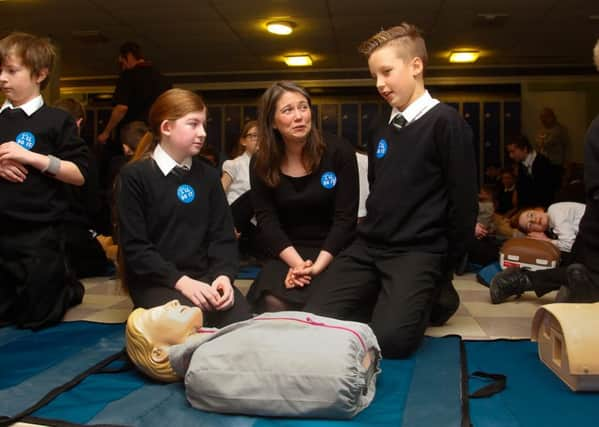Lizzy Buchan: Join us to help save lives by learning CPR


Would you walk past, too afraid to act, or would you become one of the thousands of Scots who know how save a life?
CPR - or cardiopulmonary resuscitation - is an emergency procedure where someone delivers chest compressions on to a casualty, which pumps their blood around the body when their heart has stopped beating.
Advertisement
Hide AdAdvertisement
Hide AdSince the Scottish Government launched its cardiac arrest strategy last year, more than 60,000 Scots have been trained in how to do CPR.
This a great start towards their goal of equipping half a million people with life-saving skills, and saving 1,000 extra lives by 2020.
The Save a Life Scotland team came into The Scotsman offices yesterday to train more than 70 members of staff how to do CPR.
The response to the training was overwhelmingly positive, as many shook off their preconceptions about how difficult or dangerous it is to deliver this first aid.
One journalist told me she had been afraid she would break someone’s ribs or do them more harm than good with her compressions, until paramedics reassured her that was not true.
Another was worried it would be complicated but by the end of the session she was demonstrating how to use a defibrillator with practiced ease.
One colleague had actually done CPR before when someone collapsed outside a football ground but he was reassured to learn more about how the technique works.
These are now 70 additional people going about their daily business who know how to save lives.
Because CPR really does work.
Advertisement
Hide AdAdvertisement
Hide AdIt helped the father-of-two who was resuscitated by his wife, the jogger who was helped by a passing stranger, my 25-year-old friend whose life was saved by shop assistants.
Sadly there are many who do not make it.
The list includes high-profile cases of teenage footballers Kieran McDade, from North Lanarkshire, and Jamie Skinner, from Edinburgh, both fit and healthy yet struck down in their prime because of the cruelty of cardiac arrest.
A cardiac arrest can hit anyone at any time, when the heart stops beating and the person loses consciousness.
Every week 70 Scots suffer a cardiac arrest yet only four will make a meaningful recovery.
It is not the same as a heart attack where the blood supply is interrupted to part of the heart. This can cause permanent damage but the person remains conscious and still breathing.
The only way to ensure someone’s survival from a cardiac arrest is prompt CPR and defibrillation, as chances of survival drop by 10 per cent every minute.
Earlier this year, my friend suffered a cardiac arrest while he was working in a shop.
The only reason he is still alive is because his colleagues gave him CPR immediately. Paramedics arrived minutes later with a defibrillator and he was taken straight to hospital.
Advertisement
Hide AdAdvertisement
Hide AdThis chain of survival only functions when every part joins together and we all have to be part of it for it to work.
So take 15 minutes out of your day to learn how to save someone’s life. Save a Life Scotland - www.savealife.scot - delivers free CPR training to anyone who wants it, from schools and businesses to community groups.
I’ll do it - will you?